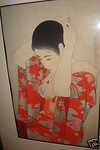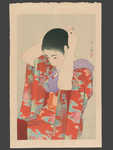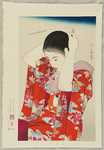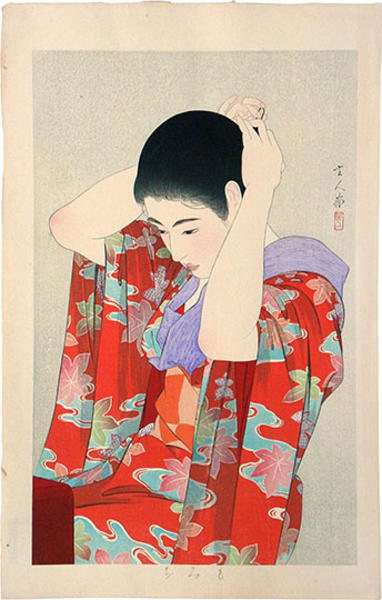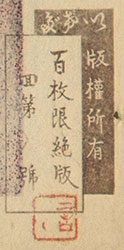| | |
| Artist: | Torii Kotondo (1900-1976) — 鳥居言人 |
| Title: | Autumn Leaves (Momiji) — 紅葉 |
| Series: | |
| Date of first edition?: | 1933 |
| Publisher (first edition)?: | Ikeda — 池田 |
| Publisher (this edition)?: | Ikeda — 池田 |
| Medium (first edition): | Woodblock |
| Medium (this edition): | Woodblock |
| Format (first edition): | Large Oban
|
| Format (this edition): | Large Oban |
| DB artwork code: | 48023 |
| Notes (first edition)?: |
"Autumn Leaves"
by Torii Kotondo, 1934
Dated 1933 (confirmed. Month not yet confirmed).
Limited edition of only 100 prints, after which the blocks were destroyed.
Scene number 10 among 12 Ikeda published scenes.
Documentation: illustrated in The Female Image: 20th Century Prints of Japanese Beauties Hotei, 2000, page138, illustration 185
Note: To date (2022) I have not seen a single example of this scene that has an edition number written on the verso cartouche. All three example that I have viewed have no edition number. |
|
| Notes (this edition)?: |
| The following information was taken from the original web listing of this artwork. Note that there may be some inaccuracies:
Torii Kotondo
1900-1976
Autumn Leaves
(Momiji)
signed Kotondo with rectangular artist's seal Kotondo, the title along the lower margin, Momiji (autumn leaves), with publisher's limited edition cartouche on verso, Ikeda hanken shoyu, hyaku mai kagiri zeppan, -- kai dai -- go (copyright Ikeda, edition limited to 100, -- printing, -- number), with artist's seal Kotondo
dai oban tate-e 18 1/2 by 11 3/4 in., 47.1 by 29.7 cm
This print, already one of the more scarce designs published by Ikeda, is a very rare variant impression printed without blue bokashi along the top edge, a darker purple color on the collar, and greater saturation of pink on her cheeks and upper arms.
References:
Kato, Junzo, comp., Kindai Nihon hanga taikei, 1975-76, Vol. 3, pl. 108
Gallery Beniya, Torii Kotondo, 1995, p. 19, no. 10
Reigle Newland, Amy, and Hamanaka Shinji, The Female Image, 2000, p. 138, pl. 185 |
|
| Artist Bio: |
| Torii Kotondo (or Torii Kiyotada VIII) is renowned for his paintings and shin hanga prints of beautiful women. His woodblock prints, superbly carved and printed, are comparable with those of Hashiguchi Goyo and Ito Shinsui. Kotondo was born with the name Saito Akira in the Nihonbashi district of Tokyo. He was the only son among the five children of Torii Kiyotada, the seventh Torii master. The Torii school had a long tradition of painting and printmaking for the Japanese theater, extending back to the seventeenth century. Kabuki theater was still very popular in the early twentieth century and prints and painted posters were the primary means of publicity. Although Kotondo was mainly interested in studying history and archaeology, it was assumed that he would follow in his father's footsteps and join the Torii school. At age 14, Kotondo agreed to leave school and begin studies with Kobori Tomone, a yamato-e painter. Along with painting classes, Tomone taught Kotondo about the court and military practices of ancient Japan, satisfying his interest in history. A year later, he was officially adopted as the next heir of the Torii school and assumed the artist's name 'Kotondo'. While still studying with Tomone, he began designing illustrations for a theatrical magazine, Engei Gaho ('Entertainment Illustrated Magazine'), and painted kabuki posters and billboards. Torii Kotondo was the 8th Torii and the 5th Torii Kiyotada. His father was the 4th Kiyotada.
|
|




